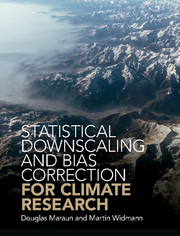Book contents
- Frontmatter
- Dedication
- Contents
- Preface
- Acknowledgements
- 1 Introduction
- Part I Background and Fundamentals
- Part II Statistical Downscaling Concepts and Methods
- Part III Downscaling in Practice and Outlook
- 15 Evaluation
- 16 Performance of Statistical Downscaling
- 17 A Regional Modelling Debate
- 18 Use of Downscaling in Practice
- 19 Outlook
- Appendix A Methods Used in This Book
- Appendix B Useful Resources
- References
- Index
18 - Use of Downscaling in Practice
from Part III - Downscaling in Practice and Outlook
Published online by Cambridge University Press: 27 December 2017
- Frontmatter
- Dedication
- Contents
- Preface
- Acknowledgements
- 1 Introduction
- Part I Background and Fundamentals
- Part II Statistical Downscaling Concepts and Methods
- Part III Downscaling in Practice and Outlook
- 15 Evaluation
- 16 Performance of Statistical Downscaling
- 17 A Regional Modelling Debate
- 18 Use of Downscaling in Practice
- 19 Outlook
- Appendix A Methods Used in This Book
- Appendix B Useful Resources
- References
- Index
Summary
Users of climate information, as broadly discussed in Chapter 5, require credible, defensible and actionable information as a basis for decision making. This chapter intends to close the circle and comes back to these initial requirements.
In Part I of the book, we discussed the broader context of climate projection uncertainties in the light of observational limitations as well as the skill and remaining shortcomings of dynamical climate models. In Part II, we introduced the range of statistical downscaling approaches and methods and discussed their structural skill and limitations as well as the assumptions underlying their use in climate projections. In Part III, finally, we have reviewed the performance of many of these methods in practical applications.
In the following sections, we synthesise the relevance of these issues for generating and providing useful regional climate projections. We assume a stance in the spirit of Mastrandrea et al. (2010), who highlight the need of bottom-up/top-down vulnerability assessments that bring together bottom-up knowledge of existing vulnerabilities with top-down climate-impact projections.
Hewitson et al. (2014) call for considering statistical downscaling in a wider landscape of climate information. In fact, users of climate information do not care about which method has been used to generate this information as long as it meets their requirements. We therefore explicitly assume a method-agnostic stance: we do not restrict ourselves to discussing statistical downscaling options but also present situations in which dynamical downscaling might be required or in which no downscaling might be needed at all.
Regional climate modelling might be purely curiosity driven. In this chapter, however, we assume a user-relevant context and thus a collaboration between regional climate modellers and stakeholders such as impact modellers or decision makers. Section 18.1 highlights the relevance to first assess whether climate and climate change are important factors in a given context. Sections 18.2 to 18.4 then summarise the discussions throughout the book about how to select suitable climate models and downscaling methods for a given application. The actual interpretation of the results in the context of projection uncertainties is the subject of Section 18.5. Section 18.6 emphasises the need for interdisciplinary collaboration but also critically discusses the difficulties of such efforts.
- Type
- Chapter
- Information
- Statistical Downscaling and Bias Correction for Climate Research , pp. 269 - 280Publisher: Cambridge University PressPrint publication year: 2018



